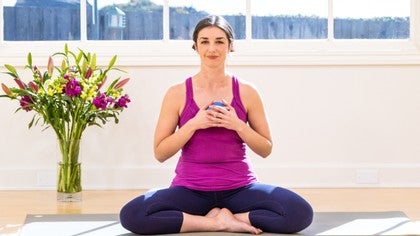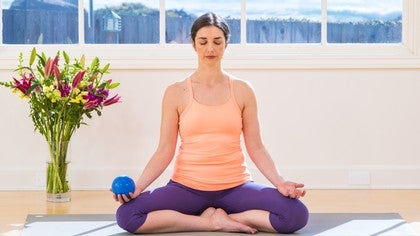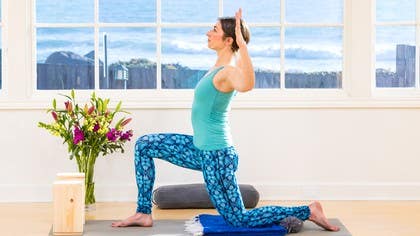Description
About This Video
Transcript
Read Full Transcript
(waves crashing) Ji. And welcome back. Before we get started, I want you to look at the physical space around you. What's there? Perhaps it's your laptop.
Perhaps it's a furry friend. Perhaps it's your phone. Perhaps it's family. But just notice. How does the external world influence your practice right now?
And if you need to change anything, change it. Perhaps turning off the cell phone or inviting the furry friend closer or away, but just create the space that will allow you to get in touch. And that's what we're going to be doing today, is get in touch, with out bodies, our mind, our spirit. So we're gonna be talking about BRFWA. It's a practice that comes from the lineage of Kripalu, and it's a great way to move from your day, whether it be super busy or slow, but to be able to come onto the mat and create and embodied practice.
I think of BRFWA also in a way of bravery. It's not easy to step on the mat especially after a long day. To get in touch. It's resiliency. It's feelings.
It's welcoming. And it all encompasses awareness. The real BRFWA is breathing, relaxing, feeling, watching and allowing. So we're gonna play around with BRFWA through the practice of the gertie ball. And you don't have to have a gertie ball.
You can have any type of ball that is available to you. It can be a tennis ball. It could be your dog's ball. It could be whatever. You could use a block.
You could use whatever it is that will bring touch to your body. Today I'm gonna use a gertie ball. I absolutely love these. Put this aside. The gertie ball, you can have it as hard or as soft as is right for you.
But we're gonna play around with just touching our bodies to bring ourselves some presence on the mat. So you can just get started by bringing whatever object you have to your heart. And just taking a few breaths, and feeling some of the pressure of the ball against your skin, against your breath. Against your bones. Perhaps closing the eyes.
Perhaps having a soft gaze. (breathing) And that physical space around you might begin to melt. So we're beginning with breaths from BRFWA. How does the breath move in your lungs? Is it small?
Is it short? Is it long? And just finding the breath that is right for you. And from your breath, do the cells of your body begin to melt? Do you feel a softening?
Or is there still a hardening? Is there a part of your body that could relax into the gertie ball just a little bit more? (breathing) And this is where feeling comes in. So we're gonna being to feel. We're gonna being to move the ball over our skin, over our bodies.
Taking it wherever. There's no right or wrong way of doing this. Just beginning to feel across the body. Making contact. You can follow along with me.
You could do it on your own. Whatever it feels like. You might choose to find safer spots before moving to some of the harder places to make contact with. Could be the front side of your body. Could move up to the upper chest and collar bones.
But just finding some freedom here. Just exploring. Shoulders. Arm pits. Down the arms.
Towards the hands, fingertips, palms perhaps. Noticing parts perhaps that you don't touch, that feel a little bit more uncomfortable for you. You just notice that discomfort. Noticing the witness that comes up in your inner critic, or brain as you find different areas of your body with the touch. You might even choose up the neck to your face.
Be kind of silly. Up to the crown of your head. Sometimes the practice can be really fun with exploring the chakras and touching all the chakras of the body, if you're familiar with that. Choosing both arms, both sides of the body. What is the inner critic tell you?
Or the inner mind as you find different body parts? Moving to the backside of your body. Backside of the heart. Some people call this the shadow side of the body, so it might feel unfamiliar to you or it might feel familiar. Finding the parts of the spine.
The parts of the ribs. Down to the belly, organs. Down to the pubic bone, pelvis, lower back sacrum area. You might choose to come down the thighs. And just maybe even noticing how much pressure you're putting into the body.
It could be a soft pressure. It could be a hard pressure. We explore the pressure of the gertie ball in the video on tone, so you might be familiar with that. Down towards the butt. I call it the fabulousness.
Maybe to your feet. The pada. The plantars. So as we become familiar with our bodies, you might notice our external relationship to our physical form, and you might also start to notice the internal relationship as you find the pressure. And then find a part of your body that you struggled with a little bit, that felt a little uncomfortable.
That arose deep sensation. And then pause there. I'm feeling it in my belly today, so I'm going to pause right there. And we'll come back to BRFWA. Again breathing, relaxing, feeling, watching and allowing.
(breathing) Take a moment to settle there. What arises? Is there anything in you mind that pops up? Or is it just a physical sensation? What does it feel like?
What do you sense? Is there the ability to relax around the gertie ball? You might notice that it does relax, or maybe it doesn't. This practice is imperfect. There's no right or wrong way to do this.
Can you allow yourself to be here? (breathing) Perhaps noticing the relationship between your hands, the gertie ball, and that place of interest. Take one deep inhale. Open your mouth and exhale. Oh that was good.
Let's do it one more time. Deep inhale through your nose. Open your mouth, audible sigh. Just give one last deep pressure to that place. And we'll begin to move forward in the practice.
And we'll come supine on our backs to explore our vertebrae to explore our spine with that same prop. So put everything away. I'm going to put away the bolster and the green ball. And then come to the front of your mat. I like to begin with my knees bent.
I find it's more supportive for the lower back, but if you would like you can also extend the legs forward. It's really up to you. We're gonna start with the gertie ball at the base of the skull. So you're gonna roll back. You can use your hands to support you as you come down.
And find a comfortable position. And bringing the gertie ball behind the head, about where the neck meets the skull. I'm going to start with my arms outright. You might have your arms by your side. You could have your arms up above.
Just explore what is right for you in this moment. Take a couple of settling breaths. When I start a practice, I like to find my body's relationship to gravity. And when I find that relationship, it just informs me of my body's weightedness against the earth. And you might feel gravity's play on the head, there's this nice little balance that occurs.
And we're going to being to make our way down the vertebrae, down the spine. Taking about three breaths or so in each place. So three full breaths at the back of the head, seeing if you can release, using the scan of BRFWA. And then to being you can either roll yourself to your neck or you can lift your head and place the ball at the neck. And you might feel the back of the head drifting back towards the floor, in a soft back bend.
And depending on the flexibility of your neck, of your cervical spine, you may or may not need a larger ball. You may want a smaller one. But just notice if this is right for you. Couple of breaths. (breathing) And then we'll move the ball to the place the upper spine and the neck meet.
So again you can choose to lift your head and move the ball or you might choose to roll. I'm on a sticky mat which makes this a little bit more difficult, so if you would like to try this on a wood surface or on your carpet you're more than welcome. It might give you different experience. Couple of breaths. What do you feel in this part of your spine?
Let's roll a couple of inches down. Still existing on the upper spine. I'm noticing myself here just behind the heart, behind the sternum. Couple of breaths. Noticing if there is any movement.
Small movement. Softening. Hardening that exists here. And then a little bit farther down. Couple of inches.
I tend to sigh a lot in this movement. So if it comes to you as well, take it. And if there's any sensation in the back, your feet can come along with you, knees can touch. Deep phenomenal breath here. (breathing) With the next exhale, let's move to the mid-back.
Perhaps the shoulders begin to touch the earth. Perhaps there's even more expansion of the anahata chakra, the harta chakra. Take one more deep breath. Then beginning to make our way to the upper lumbar spine. Noticing here what is right for you.
If there is any discomfort, perhaps use another prop. You could use a blanket. You could even just use a hand to find a sensation here. Two full breaths. At the bottom of that exhale moving into lumbar spine even more.
How does the breath feel? What have you experienced here so far? And if you are in a different part of your spine that's okay too. Our experiences might be a little different. And then rolling a little bit further into the lumbar spine.
And there might be a couple of times where you have to adjust your clothing, and that's okay too. Again we're just trying to make this comfortable. Feeding into the relaxation that's in BRFWA. And at the bottom of the next exhale, I'll be moving towards the lower part of my lumbar spine, I'm just going to have to pick up and move the ball here, adjusting my clothing a little bit. Can you find the breath moving across the sacrum?
What does it feel like? What does the witness in your mind see? And the next time the gertie ball rolls, I'm going to find myself at my tailbone, the last position of this spinal roll. I like to take a couple of micro movements here. A nice rock from side to side.
Or a tilting of the tailbone down and up. And after a couple of movements, settling myself back into stillness. And breathe. Noticing the play of gravity here. Then with your next exhale, feeling the completeness of your spine.
Pressing into your feet. Perhaps lifting the hips, grabbing the ball and slowly rolling the spine back down. Then from here, I'm going to sit myself upright, to return to my mat. And I'm gonna come back to a supine position, a shavasana like position. Rolling myself down, this time extending my legs fully, and to finish here, bringing that gertie ball to your naval, your belly, placing both hands on top of it.
And I'm gonna finish my practice here in this shavasana, with the support of the ball. You are more than welcome to stay in shavasana for as long as is right for you. And I will begin to guide us out of this position, by first just bringing your awareness back into the physical space. The physical space that I asked you to become aware of at the beginning of the session. Does it feel the same?
Does it feel different? Does it influence your shavasana? Does it influence your breath or your mind? And then bring your attention to the internal space within your body. Similarly notice as you did with the external physical space.
Then allow it to become alive. You might take a stretch. You might wiggle fingertips and toes. And from there whatever is more comfortable, you might choose to roll yourself over to a fetal position. If that's not comfortable in your body, you might choose to sit upright.
And then using a hand if you're in that fetal position, to press yourself up, and just come back to your seat. And we can close the practice, either in prayer with the gertie ball, or setting the gertie ball down and bringing the palms together. Letting the thumbs touch the heart. Bowing your brain to your heart center. Your heart center towards your body.
And just giving thanks to our bodies for everything that they do day in and day out. Namaste.
Yoga Love: Love Your Body
Comments
You need to be a subscriber to post a comment.
Please Log In or Create an Account to start your free trial.







 V E IT!
V E IT!


